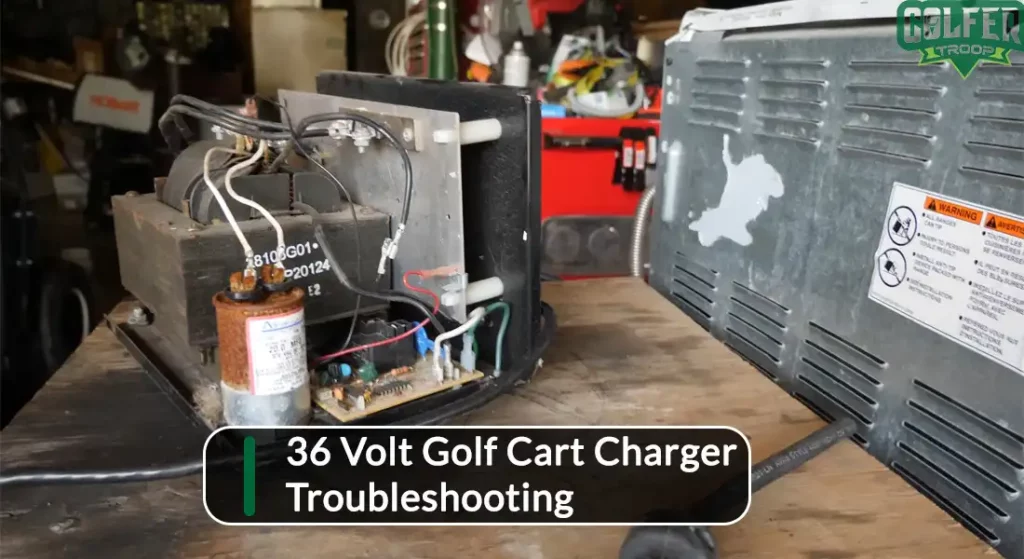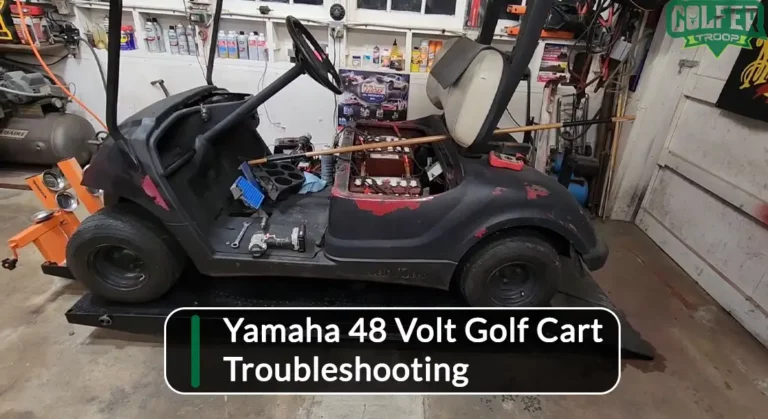36 Volt Golf Cart Charger Troubleshooting | Ultimate Guide
As a golf cart owner, you may face various issues that require regular maintenance and upgrade. Your golf cart battery charger may need to be troubleshooted frequently. Hence, we have come up with a 36-volt golf cart charger troubleshooting steps and other necessary information.
Damaged three-pin connectors, blown fuses, faulty circuit boards, loose wiring, defective diodes, malfunctioning DC plug, etc., are the main common problems that a golf cart battery charger can face.
By noticing these issues, you should take the necessary troubleshooting steps. And this article will let you know the troubleshooting guide, possible causes, symptoms of the issue, and fixing cost.
Let’s start to learn.

What Are The Symptoms Of 36 Volt Golf Cart Charger Problems?
By noticing some common symptoms, you can determine whether the actual problem is with the charger or other components.
And here is a list of common symptoms of your 36-volt golf cart charger problem.
- The charger won’t turn on.
- The Battery doesn’t get charged.
- The battery doesn’t get a connection.
- Suddenly kicks off
- Loud clicking noise from the charger
- The charger never stops charging
36 Volt Golf Cart Charger Troubleshooting Guide
Among many issues with your 36-volt golf cart charger, here we have come up with the most common ones.
So, after noticing one or more than one symptoms, you have to look for the upcoming problems. Let’s look at the brief description of problems that your cart can face.
Bad Timer Unit And DC Charger Plug
The most common golf cart charger issue is a bad timer unit and faulty DC charger plug. If the timer unit gets faulty, the charger won’t cut off.
There are two types of timers: manual and automatic. The timer unit can be faulty because of a bad solid-state circuit board. And this is a serious case, undoubtedly.
On the contrary, a defective DC charger plug won’t allow your battery to get charged. Dust and other objects can get jammed onto the plug, preventing the proper connection.
You may notice the DC plug is excessively hot and get melted. Even a bad DC plug will be responsible for a fire hazard.
Loose Wire
The charger wires or battery cables can be loose or damaged. At the same time, the cables and wires can be broken for various reasons.
Even the cables can melt in some serious cases. If the excessive current passes through the jumper cable, it can melt your golf cart charger cable. And overheating is the first step in this case.
Poor connection between the engine and chassis can also be responsible for melting your charger cable.
Damaged Fuses
The fuse has a great role in protecting the charger components whenever the charger diodes fail. But, you may notice that the fuse of your charger gets damaged.
The battery won’t be charged if the fuse gets blown or damaged. Now the question is, why does the fuse get damaged? It can happen for various reasons, such as a loose connection, a coverless wire, etc.
Faulty Diodes
Basically, a diode is a gate used for electricity. Unfortunately, a particular diode or multiple diodes can be damaged simultaneously.
And faulty diodes will not let the battery get charged. Notably, you will notice a beep or buzz whenever the diodes get damaged.
The diode can’t endure overvoltage. So, after forcing overvoltage on the diodes, they tend to get harmed.
Clicking Sound
It is a very common issue for your 36-volt golf cart charger. You will hear a clicking sound whenever you charge the battery. Ensure that the sound comes from the charger.
Notably, the battery won’t get charged in this condition. This situation will let you know that your charger is facing some critical issues.
To examine these issues, you should call an expert, or you can do it yourself if you are an expert in this field.
Transformer Issue
The 36-volt golf cart battery charger contains transformers to support the charging system.
Usually, transformers won’t create issues. But unfortunately, the transformers can get worse and even catch on fire in a serious case.
The main task of the transformers is to supply the AC power to DC power. And the DC power will send it to the battery bank. However, the total system will fail if the transformers get bad.
Notably, you will hear a humming sound from the transformer if it gets bad. And it is the most common sign of this issue.
How To Fix 36 Volt Golf Cart Charger Problems?
After noticing any of the described issues, you must take immediate repair action.
And the repairing process must be accomplished with some common steps. Let’s know these steps you must consider.
Check Charger Connection
At the beginning of the process, you must check out the golf cart charger connection. Here is a list of items you should check.
- The outlet: Determine that the wall outlet is in good condition. If you find any fault, repair it.
- Wires: You may find frayed wires while checking the overall connection. Replace the wires.
- Charger cables: Broken or damaged charger cables must be changed.
Change Timer Control Unit
Whenever you notice a bad timer unit, determine the exact issue. Maybe the issue is with the timer switch of the manual timer unit of your 36-volt golf cart charger. If so, you have to change the switch.
On the other hand, you may need to change the whole timer unit if it shows an inaccurate result. Otherwise, the batteries may get overcharged.
Replace DC Plug
From a bad DC plug, you can face various hazardous issues. Hence, you should check it carefully and replace it if needed.
Sometimes, dust jammed at the pins, receptacle, and plug itself. So, you should clean them properly.
Then, slightly connect the plug and ensure the battery gets charged, reading the timer.
If you still face issues, you have to replace the DC plug.
Replace Fuses And Diodes
Faulty fuses are very common issues for a golf cart charger. To replace a faulty or damaged fuse, you must first test it.
Use an ohm meter to check it. After confirming the fuse is dead, you must remove it from its socket.
Then, detach the wires with a screwdriver. After that, you should connect the new fuse with wires and adjust it firmly.
Most importantly, fuses and diodes are highly interconnected. Hence, a faulty diode can create an impact on the fuses. So, before changing a fuse, you should look at the diodes.
You must check the diodes. It is faulty if you see current on both sides or neither of a diode.
Check all of the diodes one by one. Now, remove the defective ones and attach new diodes.
Change The Transformer
Changing the transformer of a golf cart charger means a lot of expenses. So, you should check it well and make sure it is actually defective.
In this case, connect the charger to the outlet and try to hear the humming sound from the charger. If you can’t hear the sound, the transformer is dead.
To replace the transformer, unscrew the old one and detach the wires. Now, attach the new transformer to the slot and firmly connect the wires.
How Serious Is The 36 Volt Golf Cart Charger Problem?
You will be worried after noticing any symptoms of serious issues on your 36-volt golf cart charger.
Indeed, all the small issues should be considered serious problems because you won’t be able to charge your cart otherwise.
So, you can’t ignore a single issue in this regard. Bad fuses, defective diodes, broken wires, etc., are common issues, and you can fix them yourself.
But a faulty transformer or damaged circuit board will be a serious cause for your golf cart charger.
However, never neglect a single issue and take immediate fixing strategies.
How Much Does It Cost To Fix 36 Volt Golf Cart Charger Problems?
The overall fixing cost depends on your golf cart battery’s issue. Indeed, fixing broken wires, cables, plugs, or other common parts will not cost more than 50$.
Now, check out the costs of replacing the parts of your golf cart charger.
- The cost of a new fuse will be about $20.
- The diode won’t cost more than $30.
- A good brand DC plug will cost around $15.
- You may need to pay around $90 for a new transformer.
Notably, the labor cost for these fixing activities won’t be very high.
Conclusion
As a golf cart owner, you should concentrate properly on each component of your golf cart. As the battery charger is the most basic component of your 36-volt golf cart, you should not neglect its issues.
However, we hope you have a clear concept now of the 36-volt golf cart charger troubleshooting steps. You just need to explore each step with proper concentration.
Never hesitate to call an expert if you are not technically sound to do the fixing activities. Now, reread all the fixing steps and start to troubleshoot your golf cart charger.
Good luck!
- Read Also: 5 Common Symptoms of a Bad Starter Generators (+How to Prevent)
- Read Also: Electric Golf Cart Hesitates When Accelerating: How to Fix?
- Read Also: Honda GX390 No Spark? Here’s Everything You Need to Know
- Read Also: Alltrax NPX Troubleshooting: A Comprehensive Guide
- Read Also: Delta-Q SC-48 Troubleshooting Guide with Easy Solutions
- Read Also: How to Fix Gas Golf Cart Accelerator Problems? Step-By-Step
Meet Jalal, a passionate golf writer and the driving force behind Golfertroop.com, your go-to destination for all things golfing! Whether you’re a seasoned golfing veteran or a beginner taking your first swing, Jalal is here to assist you in making the most out of your golfing experience.





